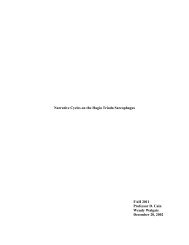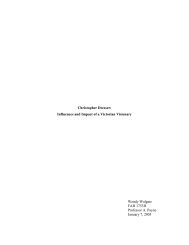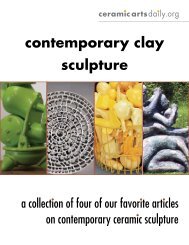Create successful ePaper yourself
Turn your PDF publications into a flip-book with our unique Google optimized e-Paper software.
put there. And sometimes, I make mistakes. Too dark a blue that conceals a curvaceous<br />
area of scroll work. Too heavy an application that completely obscures a delicate<br />
impression. With luck and a good memory, the combinations of colour can be<br />
orchestrated along with form, line, volume and content to produce a work that is<br />
provocatively whole.<br />
Surface and Content<br />
Andy Nasisse, Ceramics Monthly, January 1989 (pg. 41):<br />
Fear of the void, or the need to fill space with obsessive detail and<br />
overall patterning, is a common feature in religious art of many<br />
cultures, ranging from Gothic architecture to Islamic ceramics, to<br />
the temples of ancient Mayans, the painting of Tibetan Buddhists,<br />
to the motifs of tribal Africa and the peoples of the Upper Amazon.<br />
The visionary experience itself is characterized by reports of the<br />
visual field being filled with intricate geometric patterns, colours<br />
and textures. Perhaps pattern itself could be looked at as<br />
archetypal in nature and capable of resonating perceptions<br />
aligned with ecstatic states.<br />
Horror vacui is used to define a tendency to fill all the space, the<br />
nature of the visionary experience. I just like to articulate all the<br />
different levels of space so that there's nothing that's less or more.<br />
Everything is equally filled.<br />
A visionary image is one that results from a direct religious<br />
experience. When an individual experiences elevated states of<br />
consciousness through some unknown facility, awareness is<br />
opened to all stimuli at once. Visual, auditory, tactile, and<br />
olfactory sensation are heightened and an ecstatic state is<br />
reached. It's a sort of blowing of fuses.<br />
For the final review of my first year at Cranbrook, I produced four place settings for the<br />
table. The bowl, smaller plate and larger plate fit together and the overall effect was one<br />
completely covered with textures and colours. In a black and white photograph of these<br />
place settings, very little delineation of colour hues or forms would be seen. The work<br />
from my first year was based on thrown forms and covered front and back, top and<br />
bottom with press-moulded clay pieces.<br />
Because I was so familiar with my stable of press-mould objects, it was easy for me to<br />
understand the flow and relationship between the different patterns and surfaces. But to<br />
the viewer, it was much more difficult to single out certain objects, to recognize an<br />
overall structure in the decoration or to find a restful spot for the eye to gather strength. In<br />
16





